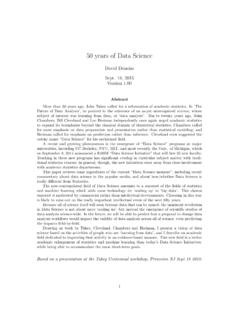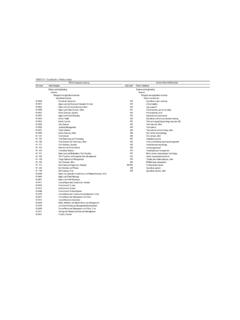Transcription of Introduction to Information, Information Science, and ...
1 CHAPTER2 ObjectivesIntroduction to Information , Information Science, and Information SystemsDee McGonigle and Kathleen on the progression from data to informationto the term how Information is the characteristics of quality an Information data acquisition or input and processing orretrieval, analysis, and synthesis of output or reports, documents, summariesalerts, and Information dissemination and Information how Information is how knowledge is generated in chapter explores Information , Information systems(IS), and infor-mation science. The key word is Information . Healthcare professionalsare knowledge workers, and deal with Information on a daily are many concerns and issues that arise with healthcare informa-tion, such as ownership, access, disclosure, exchange, security, privacy,disposal, and dissemination.
2 With the gauntlet of an electronic healthrecordbeing set, public and private sector stakeholders have been collab-orating on a wide-ranging variety of healthcare Information initiatives include Health Level Seven(HL7),ConsolidatedHealth Informatics s (CHI s) eGov initiative, the national HealthInformation Infrastructure (NHII), the national Health InformationKey TermsAcquisitionAlertsAnalysisChief Information officerChief technical officerChief technology officerCloud computingCognitive scienceCommunication scienceComputer-based Information systemComputer scienceConsolidated healthinformaticsDataDisseminationDocume ntElectronic health recordFederal Health Information ExchangeFeedbackHealth Information exchangeHealth Level SevenIndiana Health Information Exchange InformationInformation 7/19/11 1:29 PM Page 17 Jones & Bartlett Learning, LLC.
3 NOT FOR SALE OR DISTRIBUTION18|CHAPTER 2 Introduction to Information , Information Science, and Information SystemsNetwork (NHIN),Next-Generation Internet (NGI),Internet2, andiHealth record. There are also health Information exchange (HIE) sys-tems, such as Connecting for Health, the eHealth initiative, the FederalHealth Information Exchange (FHIE), the Indiana Health Infor-mation Exchange (IHIE), the Massachusetts Health Data Consortium(MHDC), the New England Health EDI Network (NEHEN), the Stateof New Mexico Rapid Syndromic Validation Project (RSVP), theSoutheast Michigan e-Prescribing Initiative, and the TennesseeVolunteer eHealth Initiative (Goldstein, Groen, Ponkshe, & Wine, 2007).The most recent initiative, the HITECH Act, has set 2014 as the deadlinefor electronic health records (see Chapter 10).
4 It is quite evident fromthe previous brief listing that there is a need to remedy healthcare infor-mation technologyconcerns, challenges, and issues faced today. One ofthe main issues deals with how healthcare Information is managed tomake it meaningful. It is important to understand how people obtain,manipulate, use, share, and dispose of Information . This chapter dealswith the Information piece of this complex someone states the number What does that mean? Itcould be a radio station or a score on a test. Now, if someone says thatMs. Howsunny s temperature is F, what does that convey? It isthen known that is a person s temperature. The data ( ) wereprocessed to the Information that is a specific person s raw facts. Information is processed data that hasmeaning.
5 Healthcare professionals constantly process data and infor-mation to provide the best care possible for their are many types of data, such as alpha, numeric, audio, image, and videodata. Alpha data refers to letters and numeric refers to numbers, and alphanumericdata includes both letters and numbers. This includes all text and the numeric out-puts of digital monitors. Some of the alphanumeric data encountered by health-care professionals are in the form of patients names, identification numbers, ormedical record numbers. Audio data refer to sounds, noises, or tones. There aremonitor alerts or alarms, taped or recorded messages, and other sounds. Imagedata include graphics and pictures, such as graphic monitor displays or recordedelectrocardiograms, radiographs, MRIs, and CT scans.
6 Video data refer to anima-tions, moving pictures, or moving graphics. One may review the ultrasound of apregnant patient; examine a patient s echocardiogram; watch an animated videofor professional development; or learn how to operate a new technology tool, suchas a pump or monitoring Terms ContinuedInformation systemInformation technologyInputInterfaceInternet2 KnowledgeKnowledge workerLibrary scienceMassachusetts Health Data ConsortiumNational Health Information InfrastructureNational Health InformationNetworkNew England Health EDI NetworkNext-Generation InternetOutcomeOutputProcessingRapid Syndromic Validation ProjectReportSocial 7/19/11 1:29 PM Page 18 Jones & Bartlett Learning, LLC. NOT FOR SALE OR DISTRIBUTIONI nformation|19 The integrity and quality of the data, rather than the form, are what refers to whole, complete, correct, and consistent data.
7 Data integrity canbe compromised through human error; viruses, worms, other bugs; hardware fail-ures or crashes; transmission errors; or hackers entering the system. Informationtechnologies help to decrease these errors by putting into place safeguards, suchas backing up files on a routine basis, error detection for transmissions, and de-veloping user interfacesthat help people enter the data correctly. High-qualitydata are relevant and accurately represent their corresponding concepts. Data aredirty when there are errors in the database, such as duplicate, incomplete, or out-dated records. One author ( ) found 50 cases of tongue cancer in a databaseshe examined for data quality. When the records were tracked down and analyzed,and the dirty data were removed, there was only one case of tongue cancer.
8 Thesame person had been entered erroneously 49 times. The major problem was withthe patient s identification number and name. The numbers were changed or hisname was misspelled repeatedly. If researchers had just taken the number of casesin that defined population as 50, they would have concluded it was an epidemic,resulting in flawed Information that is not meaningful. Therefore, it is imperativethat data be clean if the goal is quality Information . The data that are processedinto Information must be of high quality and integrity to create meaning to in-form assessments and decision be valuable and meaningful, Information must be of good quality. Char-acteristics of valuable, quality Information include accessibility, security, time-liness, accuracy, relevancy, completeness, flexibility, reliability, objectivity, utility,transparency, verifiability, and reproducibility.
9 Accessibility is a must; the right usermust be able to have the right Information at the right time and in the right for-mat to meet his or her needs. Getting meaningful Information to the right user atthe right time is as vital as generating the Information in the first place. The rightuserrefers to an authorized user who has the right to obtain the data and infor-mation he or she is seeking. Security is a major challenge because unauthorizedusers must be blocked while the right user is provided with open, easy access (seeChapter 15). Timely Information means that it is available when it is needed forthe right purpose and at the right time. Knowing who won the lottery last weekdoes not help one to know if he or she won it today. Accurate Information meansthat there are no errors in the data and Information .
10 Relevant Information is sub-jective in the fact that the user must have Information that is relevant or applica-ble to his or her needs. If one is trying to decide whether or not a patient needsinsulin and only the patient s CT scan Information is available, this Information isnot relevant for that current need. However, if one needed Information about theCT scan, then the Information is relevant. Complete Information contains all ofthe necessary essential data. If one needs to contact the only relative listed for 7/19/11 1:29 PM Page 19 Jones & Bartlett Learning, LLC. NOT FOR SALE OR DISTRIBUTION20|CHAPTER 2 Introduction to Information , Information Science, and Information Systemspatient and his or her contact Information is listed but the approval for them tobe a contact is missing, this Information is considered incomplete.


















